Learn why marketers are noticing a positive impact from holiday email opt-outs.
For email marketers, the holidays are the most important time of year for outreach. For consumers, however, the holidays are when they brace themselves for an avalanche of advertising and promotional email messages.
In fact, Capterra’s latest survey shows that more than four in five (83%) say they receive additional emails during the holidays–and the vast majority of them (90%) get up to 50% more emails, making it even harder for marketers to break through the noise [*].
Leveraging the holidays to boost sales is also off-putting for a significant portion of consumers that believe brands shouldn’t use holidays or special calendar events as cash grab opportunities. Sixty-eight percent of consumers agree that brands should prioritize consumer well-being over sales during the holidays.
This sentiment aligns with the emergence of a new trend—the holiday email marketing opt-out. This is when brands or companies offer email subscribers or recipients the opportunity to opt out of receiving specific holiday email messages or campaigns.
Holiday email opt-outs are a practice in empathy; many companies are now acknowledging that the holidays can be difficult or bring up negative feelings for some individuals. Imagine receiving a “Valentine’s Day special” right after a breakup or a “Mother’s Day sale” while grieving the loss of a parent.
But is the opt-out strategy empowering or does it come across as disingenuous? How big of an impact do holiday marketing email opt-outs really make? Capterra surveyed 869 U.S. consumers to understand their reactions to holiday or special calendar event email opt-outs or unsubscribe messages. Continue reading to find out if this strategy makes sense for your business.
/ Key findings
91% of consumers feel very or somewhat positive towards holiday email opt-outs and rate brands that offer opt-outs higher in appearing empathetic.
When receiving a holiday email opt-out notification, 39% of consumers say they would always or usually unsubscribe.
The most common calendar events to opt out of are Back to School and Valentine's Day, with 84% opting out at some point. Right behind that are Mother’s and Father's Days, the winter holidays, and Thanksgiving, all tied at 83%.
When deploying a holiday opt-out notification, it is best to send the message via email, one or two weeks in advance of the holiday or event.
Easy email management options are the first avenue to happy customers
In the world of email marketing, consent matters. Offering an easy unsubscribe option allows consumers to remove themselves from email lists and take control of the messages they want or don’t want. An opt-out is mutually beneficial as well, aiding in email list hygiene and offering an easy email management option for consumers.
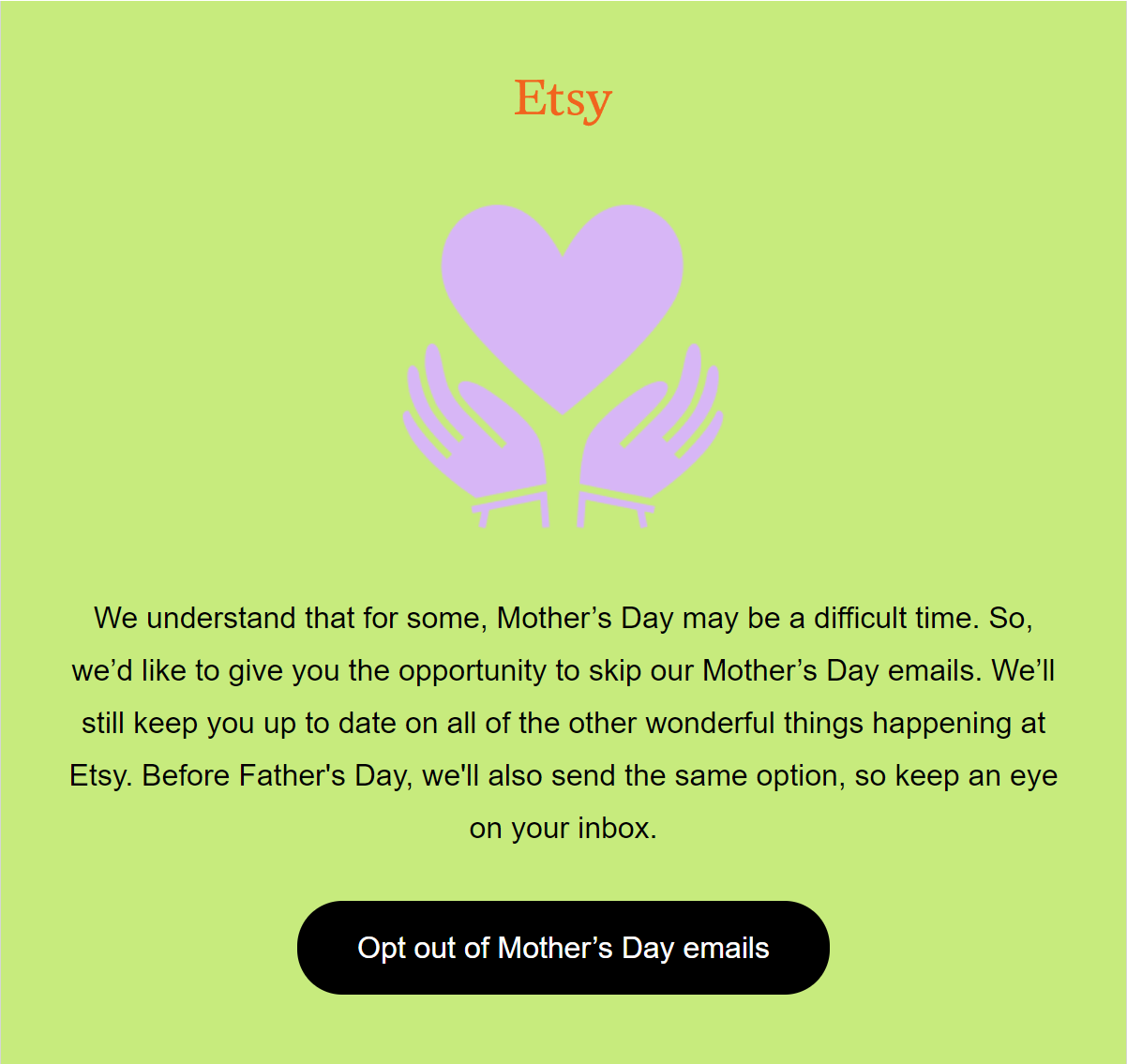
Example of a holiday email opt-out message (Source: Etsy[1])
However, companies have room to grow when it comes to providing easy and clear unsubscribe options. Fifty-four percent of consumers said they had opted out or unsubscribed from advertising, promotional, or marketing emails as recently as within the past week. Yet only one in four consumers say it’s “very easy” to opt out of marketing emails.
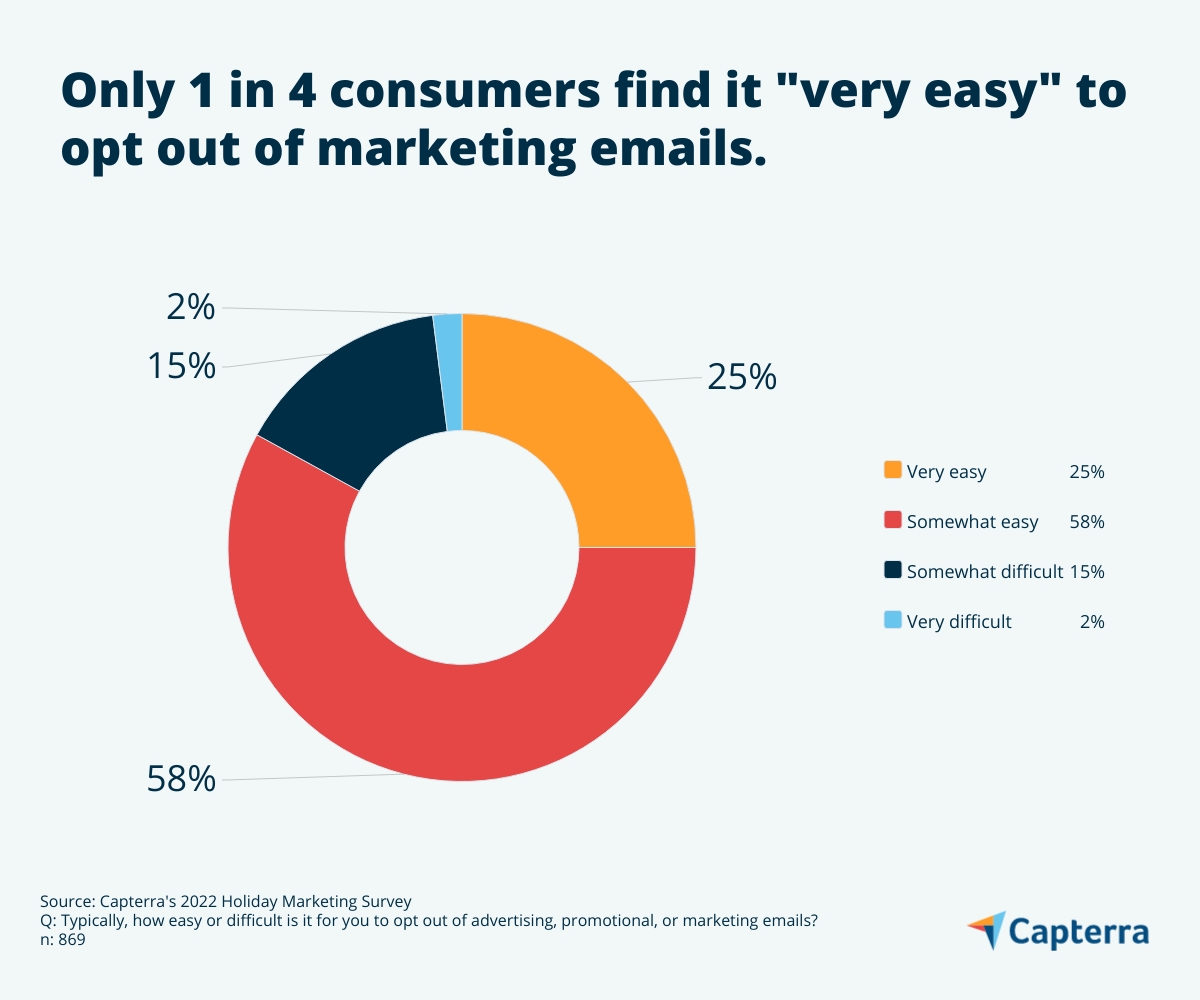
Ultimately, any type of email opt-out should be a seamless process for customers. This will demonstrate that you value each customer’s preferences, making them more likely to return when they want to hear from your company in the future.
Exactly how sensitive are consumers to holiday emails?
With that in mind, let’s take a look at which holiday and calendar events consumers are most likely to opt out of:
Audience-targeted events such as Back to School, Valentine's Day, and Father’s or Mother’s Day are the most likely to evoke an opt-out from consumers.
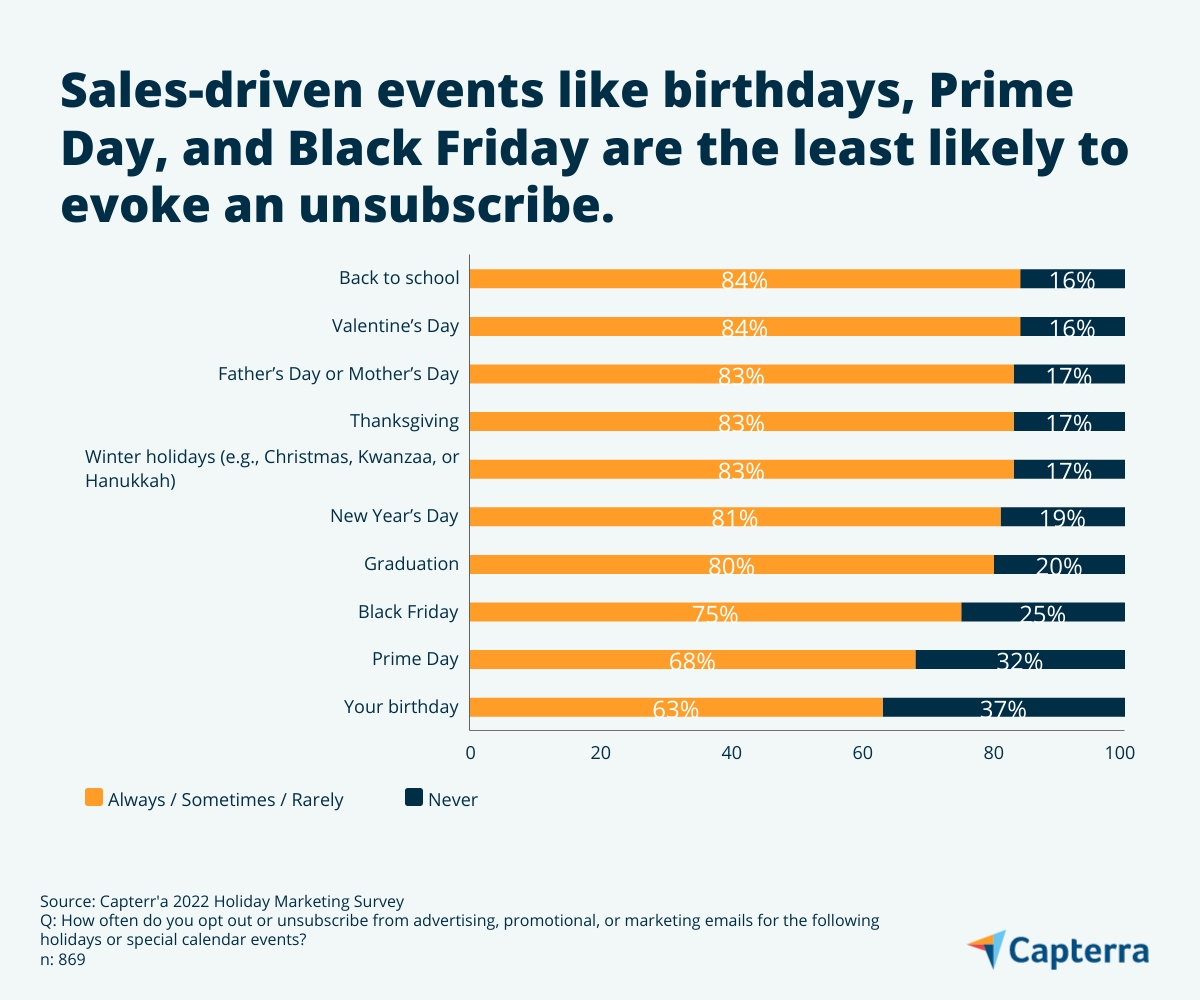
But there is good news for marketers: Calendar events typically associated with sales, discounts, or deals such as birthdays, Prime Day, or Black Friday tend to remain in consumer inboxes. However, audience-targeted events such as Back to School, Valentine’s Day, and Graduation are more likely to evoke an opt-out from consumers.
This is evidenced further when reviewing the same data by age. For example, 56% of Gen Zers (born during or after 1995) say they always or sometimes opt out of graduation promotional emails compared to 67% of Gen Xers (born between 1965 through 1979).
On its face it makes sense that consumers are more likely to opt out of messages that aren’t relevant to them. However, our research reveals that the quantity of email received is the main contributor to holiday or special calendar event opt-outs:
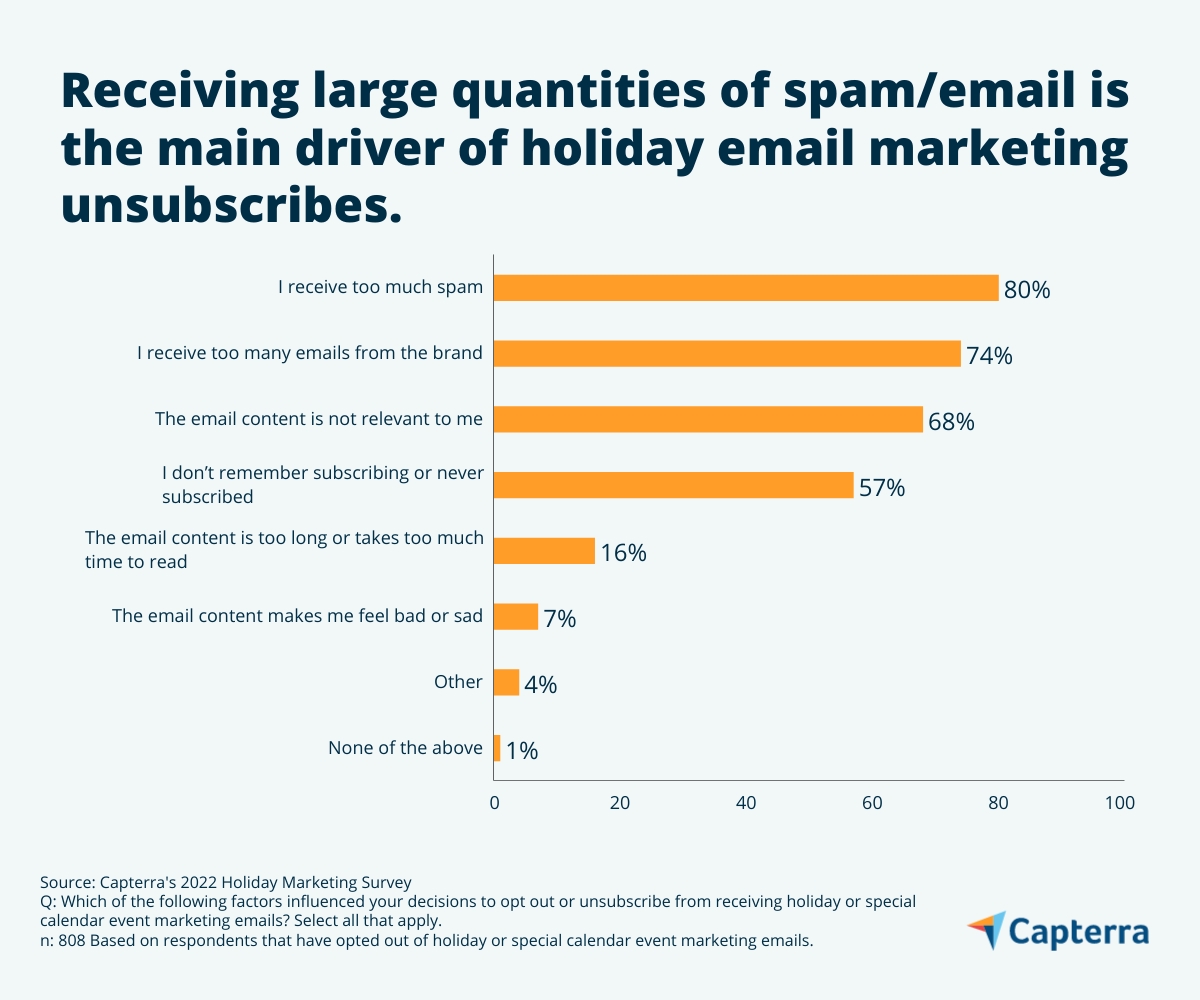
Our survey found that 58% of consumers are already checking their primary personal email accounts four times or more a day and receiving on average 20 emails a day (excluding spam or junk mail). Factor in excessive holiday promotional messages, and you’ve got a recipe for email list churn.
What makes matters worse is that many consumers aren’t even sure how they end up receiving holiday promotional emails. Among consumers that have opted out of holiday or special calendar event marketing emails, 57% say they don’t remember subscribing or never subscribed to receiving holiday email marketing messages.
If your email recipients aren’t even aware of how or why they ended up on a distribution list, they may feel more unwelcoming of marketing messages. This points to the need for businesses to be diligent in email permissions (e.g. asking customers to opt in to receive email), management, and tracking to prevent customers or prospects from receiving emails they don’t want.
The reality is that just a small percentage (7%) of consumers are triggered (i.e., feel bad or sad) as a result of holiday marketing. This is exacerbated by the fact that half of email recipients (51%) are intentionally ignoring emails that contain holiday or special calendar event messaging.
It’s also worth noting the impact of spam filters and ad blockers. According to our survey, 40% of consumers say they set up spam folders to filter out emails with holiday marketing while nearly one in four use a free or paid ad/spam blocker. Luckily, there are a portion of consumers (19%) that don’t do anything intentionally to avoid holiday or special calendar event emails.
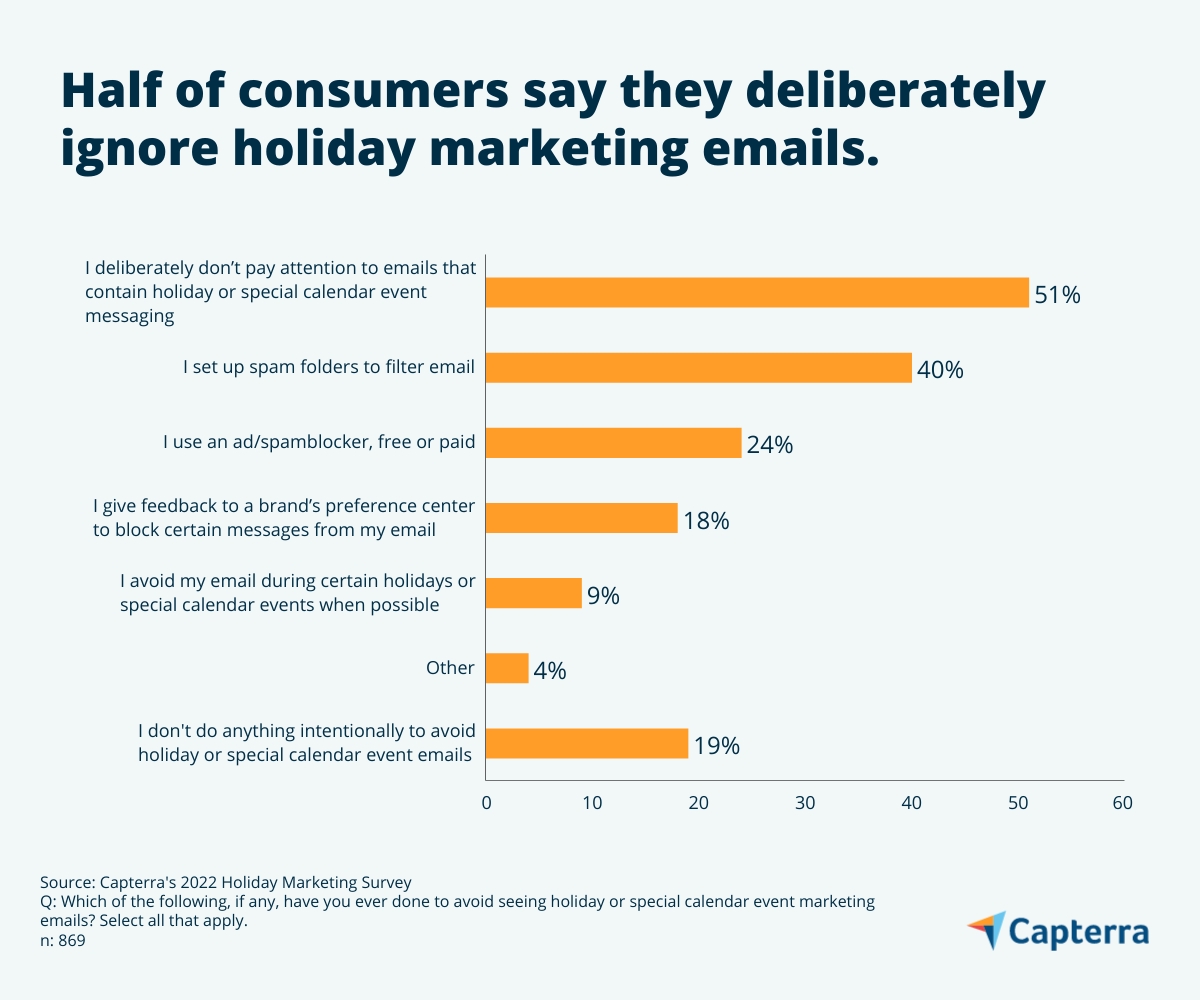
We also find that consumers are less sensitive personally towards holiday or special calendar event marketing emails, but are more concerned about the sensitivity of others. The extent of holiday message sensitivity should be a consideration among marketers expecting to greatly reduce consumer harm by adopting opt-outs.
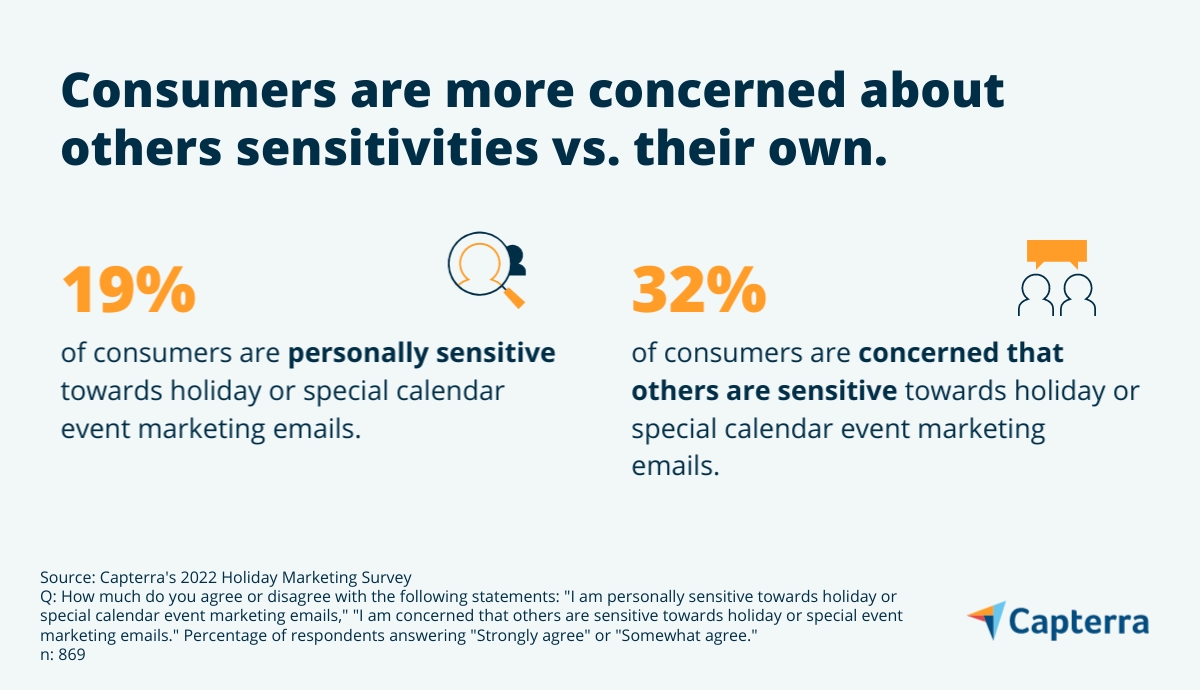
To recap, sensitivity to holiday email marketing doesn’t impact the majority of email recipients—at least not enough to raise serious marketer alarm bells. Many consumers are ignoring, blocking, or avoiding holiday marketing messages altogether.
How do consumers react and respond to holiday email opt-outs?
When shown an example of a holiday email opt-out message, the majority of consumers (68%) say they haven’t come across one. Only 19% of consumers indicate they have ever encountered a holiday email opt-out, and surprisingly, 13% aren’t even sure if they have.
Among those that have encountered a holiday email marketing opt-out message, 73% have seen between just one and three of these messages over the last 12 months—not a large presence. Yet, despite these numbers, how do consumers react to holiday email opt-out messages?
Holiday opt-out reach is low, but reactions are positive
/ Key finding
The good news for marketers that are considering or already providing holiday email opt-outs is that 91% of consumers feel very or somewhat positive towards them. Furthermore, 81% say they are extremely or somewhat likely to purchase from a brand that offers them.
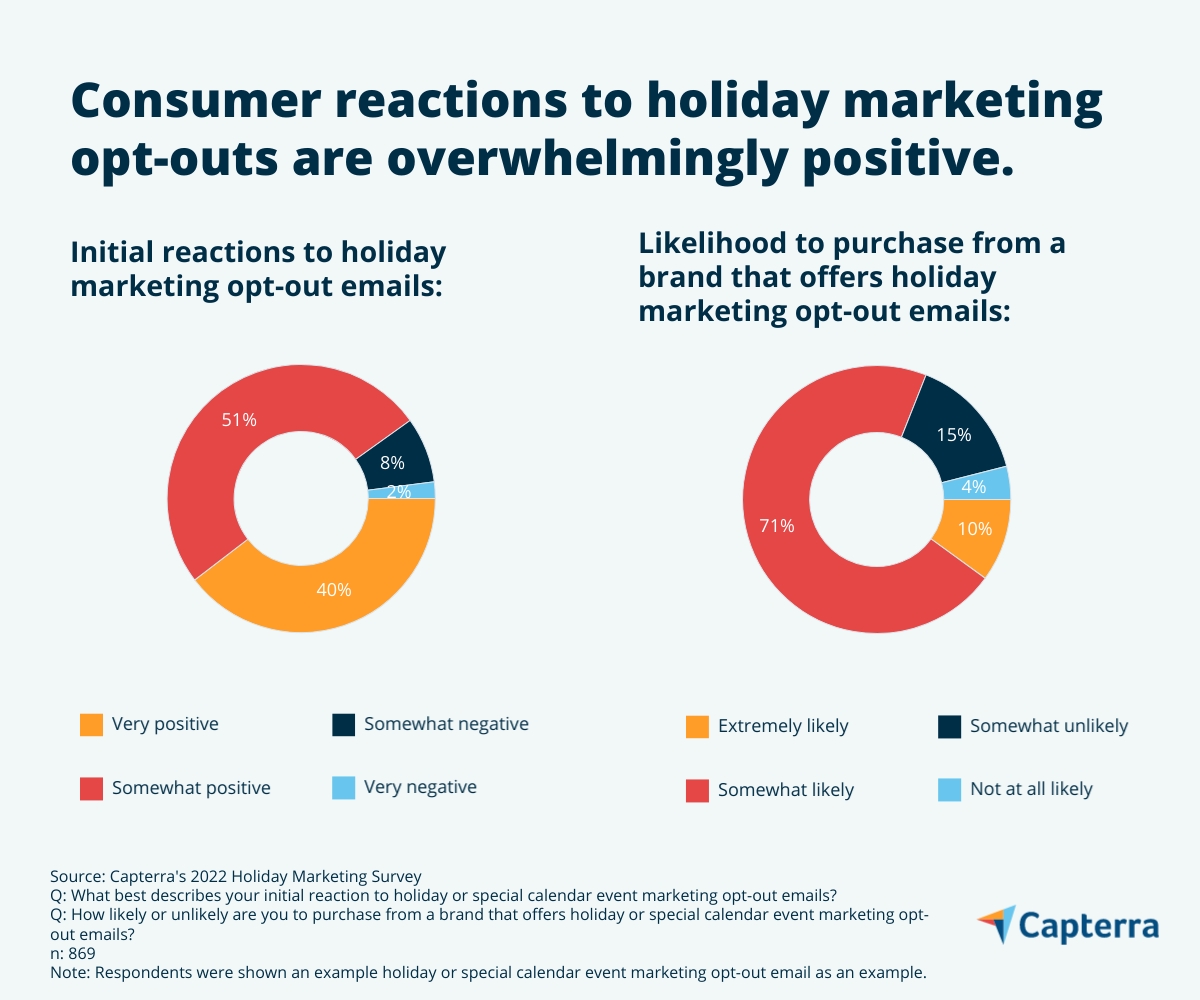
And we find that brand perceptions can be impacted positively by providing holiday email opt-outs as well. When we asked consumers to rate brands that provide opt-outs on various aspects, they rated them the highest on appearing empathetic (60%):

Nonetheless, marketers need to keep in mind how holiday opt-outs affect their unsubscribe rates and metrics. Here’s how consumers say they would respond to a holiday or special calendar event opt-out message, broken down by age and gender:
Responses to holiday opt-outs vary by email recipient demographics
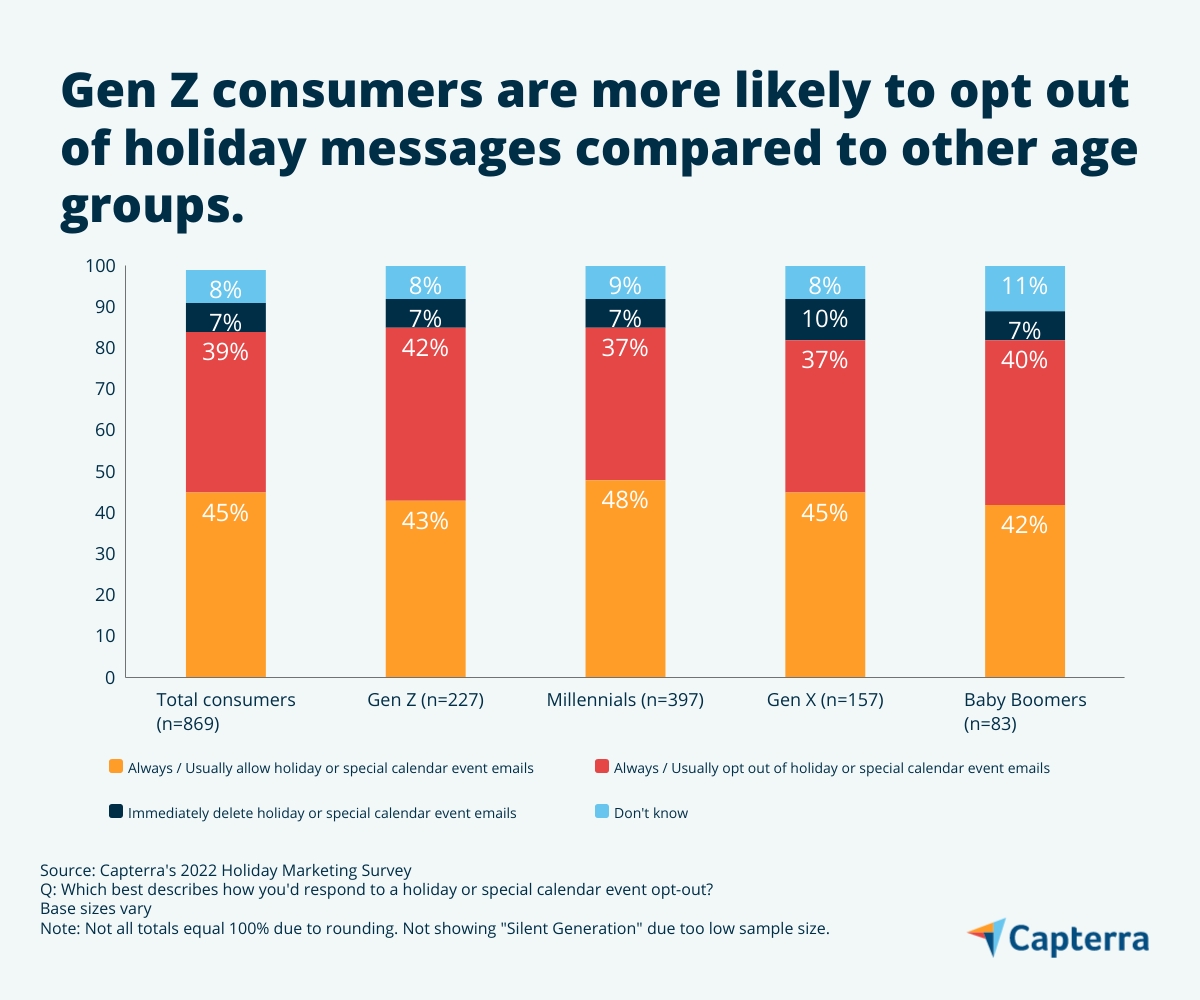
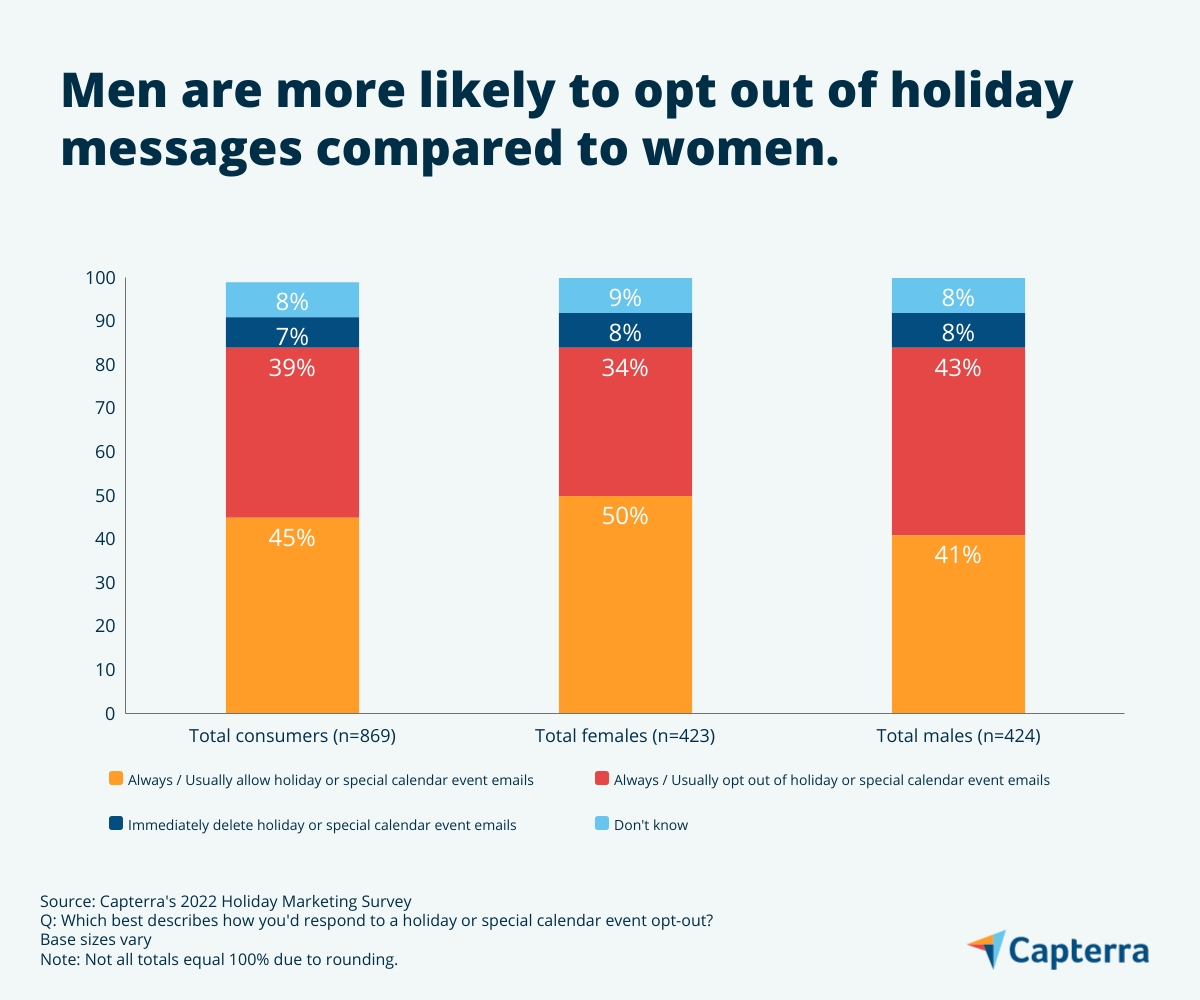
/ Key finding
Among total consumers, responses to seeing a holiday or special calendar event email opt-out are varied with slightly more (45%) indicating they’d always or usually allow holiday emails, while 39% always or usually would opt out. However, our survey found that Generation Z consumers are more likely to opt out compared to other age groups, as are men compared to women. Counterintuitively, personal sensitivity towards holiday messages did not have a significant impact on consumer responses.
Holiday email opt-outs bring about some positive reactions—they help demonstrate brand empathy, encourage some to buy, and are overall viewed positively among consumers. However, it’s important to consider the impact to your email lists and how responses vary across various consumer audience segments. There’s a possibility that adding a holiday opt-out could increase email unsubscribe rates, especially among Generation Z and male email recipients.
The what, when, and how for companies that want to offer holiday email opt-outs
If you are ready to add a holiday email opt-out to an upcoming campaign, below are a few considerations.
What to say in an opt-out message: Our research finds there are a few tactics marketers can explore when deploying a holiday marketing opt-out.
Relevance is key: 71% of consumers say they would be more likely to read and pay attention to a brand or company’s holiday opt-out message if it’s personally relevant. A well-segmented email list is a marketer’s biggest weapon to ensure the right consumers receive the most relevant messages. Email marketing software for list or subscriber management is a great resource to consider.
Keep it short: Email is designed to be read quickly. According to our survey, 63% of consumers say they would be more likely to read and pay attention to a brand or company’s holiday opt-out message if the message is short. Rather than battle for consumer time and attention, aim for between 50 to 125 words for your opt-out message.
Make it stand out: It’s also important to capture a recipient’s attention right away. What’s a better place to do that than a subject line? Our research found that 38% of consumers say they would be more likely to read and pay attention to a brand or company’s holiday opt-out message if the message contains a catchy or attention-grabbing subject line. Don’t be afraid to get creative.
Make it easy: Don’t discount the use of a website banner or pop-up, or your website’s preference center to help consumers opt out of the messages they no longer wish to receive. Our survey found that 18% of consumers indicate they have given feedback to a brand’s preference center to block certain messages from their email. Additionally, 22% of consumers say they would prefer to receive a notification from a brand or company about opting out of holiday marketing via a banner or pop-up on the company’s website. Is your company’s preference center easy to locate and navigate?
When: After crafting the right message, when is the best time to deploy it? One or two weeks in advance of the holiday or special calendar event is the ideal time to send an opt-out email.
How: Three-fourths of consumers would prefer to receive a holiday marketing opt-out notification via email. However, as mentioned above, a banner or pop-up on a company website is another good alternative.
Holiday email opt-outs are a good step toward responsible marketing and overall, reactions are positive. There are, however, a few considerations to keep in mind. Marketers must be aware that holiday email sensitivity impacts only a small portion of consumers and weigh that against the impact to their email list unsubscribe rate. Also, it’s important to consider your unique target audience as attitudes and appetites for holiday opt-outs vary, especially considering age and gender.
If you like this report, check out these additional marketing resources:

